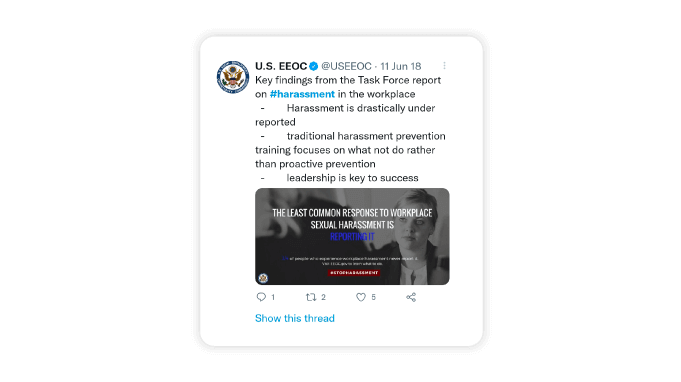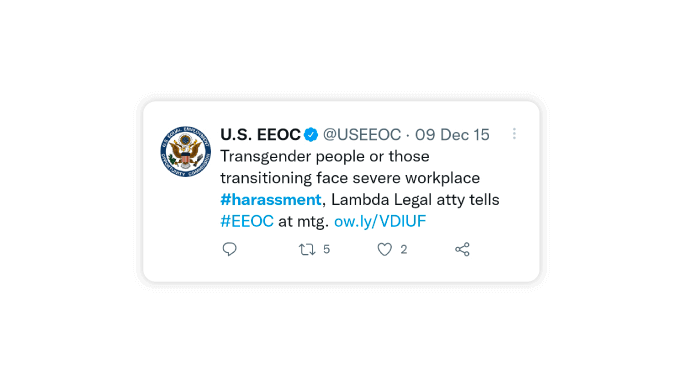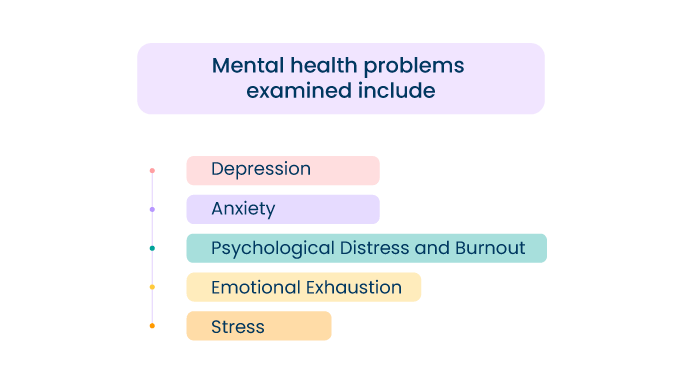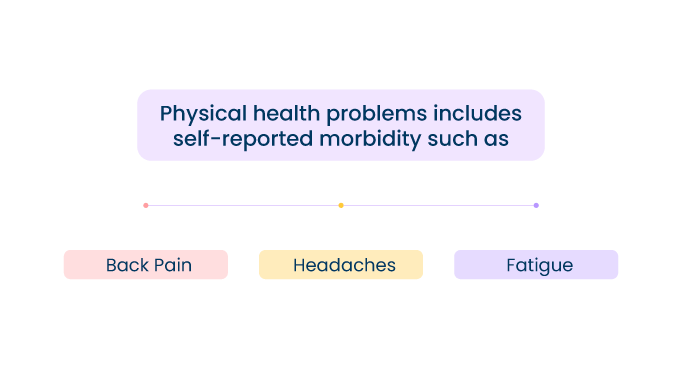Hostile Work Environment: Everything You Need To Know In 2024
Do you wake up with a feeling of anxiety? Does going to the office feel more like a punishment? Do you have a boss or colleague who is hostile to you? Or are you facing some form of harassment at your workplace?
If some (or all) of these are true. You are most likely a victim of a hostile work environment.
But, the chances are also good that you’re not the only one.
According to a survey conducted by CNBC:
One out of five employees in the United States has experienced workplace hostility.
In fact, a report published by MIT Sloan School of Management found that:
Toxic work cultures were the driving force behind the Great Resignation. It is also the biggest cause of employee attrition.
Both the survey's result is concerning at best and appalling at worst.
Thus, we cannot sweep this issue under the rug.
As a healthy workplace is not a luxury but a basic need of every professional. Employees can achieve no great results without a sound working environment.
But sometimes, the significance of creating a conducive workplace for all is overlooked.
Many employers fail to recognize the conditions leading to a hostile workplace. They often disregard its existence in the pursuit of profit. Even legal claims are straight away neglected due to sub-standard employment laws.
Thus, understanding the crux of the problem is of utmost importance. Also, it is essential to understand every aspect of workplace hostility.
So, first of all, let's try and understand the meaning of a hostile work environment.
What is a Hostile Work Environment?
A hostile work environment is one in which reasonable employees feel unwelcome. They feel alarmed by the actions or words of their supervisors, managers, or co-workers.
Legally, a hostile environment violates your employment contract. Fundamentally, it is nullyfies your aspirations of working in a safe and secure environment.
But, if you think these are the only drawbacks of a hostile workplace. Then sadly, you’re mistaken.
Hostile environments pose numerous problems for employers and employees. Such environments can negatively impact employee satisfaction, engagement, and productivity. It can develop a sense of resentment among co-workers.
An unhealthy working environment can be a source of stress for employees and employers alike.
~ Wesley Pitters
But, people often confuse a hostile work environment with working in a less-than-ideal workplace.
While having an ill-tempered boss, impolite co-workers aren't desirable. It doesn't mean the work environment classifies as "hostile."
For a workplace to be hostile, it needs to meet specific legal criteria.
According to the U.S.Equal Employment Opportunity Commission (EEOC):
A hostile environment results from harassment. Harassment based on race,color religion, sex (including sexual orientation, gender identity, or pregnancy),national origin, age (40 or older), disability, Genetic information
U.S EEOC is a federal agency that was established via the Civil Rights Act of 1964 to administer and enforce civil rights laws against workplace discrimination.
Now, since we have a decent understanding of the meaning of a hostile work environment, let's identify its signs.
Signs and Characteristics of a Hostile Work Environment
The work environment is very important in determining how enjoyable work is.
~ Kumar Mangalam Birla
All workplace cultures differ from one another. But the worst among them often have few characteristics in common. Here are some of the most common signs:
-
You find it hostile.
-
Your reasonable co-worker finds it hostile.
-
You feel stressed out most of the time.
-
The atmosphere is unwelcoming, and you feel threatened.
-
There is an environment of unhealthy competition.
-
People in your organization don't feel recognized or appreciated.
-
Team members do not see each other eye to eye.
-
Managers or HRs are unethical or don't care about employees' feelings.
-
Scapegoating and blaming are persistent and pervasive problems.
-
Favoritism is practiced blatantly.
So, these were some of the major red flags.
These signs are not enough to declare your workplace hostile. Satisfying certain other conditions is also imperative.
Thus, it brings us to the next big question, and that is:
What cannot be classified as a hostile work environment?
The term hostile work environment has the scope to include anything a person finds nasty or unpleasant. Yet, several sets of criteria must be satisfied for a workplace to be hostile.
The Equal Employment Opportunity Commission states that:
Petty slights, annoyances, and isolated incidents (unless serious) are not considered illegal.
A single incident of misbehavior creates a hostile situation for an individual. But not a hostile environment. For a workplace to qualify as hostile, it also has to be -:
-
Severe
-
Pervasive
-
Persistent
Although certain incidents may not be hostile according to EEOC. Employers must resolve any instances of bullying, conflict, or harassment.
By now, you already know what a hostile workplace is like and how to spot it. But it is not enough. You must also learn about the laws against hostility or harassment.
Laws Regarding a Hostile Work Environment
Currently, no federal law governs a "hostile work environment."
Did you know that there are no laws governing hostile work environments?
In truth, the several anti-discrimination laws of the state safeguard employees against instances of hostility.
However, employees know at least the basic anti-discrimination laws. But it’s not just an employee’s job to do that. It stands true for all employers and human resources personnel.
The reason is simple. If you want to foster an inclusive culture, it’s critical to know the laws that protect the workplace from such discrimination. These laws are critical in removing barriers to an equitable workplace.
So let’s have a look at some of the anti-discriminatory acts and their importance.
Laws at Glance
Title VII of the Civil Rights Act of 1964
Title VII prohibits employment discrimination based on race, color, religion, sex, and national origin.
Americans with Disabilities Act of 1990 (ADA)
This law disallows employers to discriminate against employees or individuals applying for a job with disabilities.
Genetic Information Non-Discrimination Act of 2008 (GINA)
GINA protects individuals or employees against discrimination based on their genetic information in health coverage and employment.
Age Discrimination in Employment Act of 1976 (ADEA)
This act forbids discrimination against workers aged 40 years or older.
Pregnancy Discrimination Act (PDA)
This act prohibits discrimination with regard to pregnancy in employment aspects such as hiring, firing or promotions.
So, these were some of the anti-discrimination laws in the United States.
Equal Employment Oppurtunity is captured in laws in different countries in different ways. It prevents both employer and peer-to-peer discrimination. It is often the first line of defense for harassment victims.
So, identify the laws in your country and research them thoroughly.
EEOC complaints must be filed within 180 days of the alleged violation. This deadline is, at times, extended to 300 days. Waiting beyond 180 or 300 days may result in dismissing the claims.
After the laws, identifying the factors leading to a hostile workplace is the next important step. Knowing the elements can help understand the problems better and unlock the ways to tackle them.
So, let's get started.
Factors that Contribute to a Hostile Work Environment
It's Essentially Harassment, Creating a Hostile Work Environment.
~Wesley Pitters
Hostility at the workplace will make a regular office day unbearable.
When a workplace is hostile, a person's ability to perform declines. It may also cause excessive mental distress and trauma.
So, understanding the factors that create a hostile work environment is important. Not only for HR professionals and corporate policymakers. It is relevant for every working individual.
So, here are some of the vital factors which contribute to a hostile environment.
1. Sexual Harassment

Sexual harassment and gender discrimination are real, and it's far more pervasive than I think people have been willing to acknowledge.
~Tony West
Sexual harassment is one of the most controversial, complex, and widespread problems for HRs.
Pervasive sexual harassment creates a hostile environment. It causes victims— both men and women— tremendous mental stress. It forces victims to leave their jobs and look for new ones. Such offensive conduct might also force them to give up their careers. This is most evident among women employees.
According to Harvard Business Review,
Some 40% of women and 16% of men have faced harassment at work. In fact, sexual harassment is one of the leading causes of workplace hostility.
What makes the scenario even worse is that many workplace sexual harassment cases go unreported. It is due to the fear of facing retaliation.

According to a report by the Business Standard:
8 out of 10 workplace harassment victims face retaliation.
Both figures are unfortunate and reveal a lot about today's corporate scenario.
Workplace Sexual Harassment does not have to be physical to qualify as an offense. Sexual harassment on call, e-mail, or other social media platforms is offensive.
2. Racial Harassment

In a racist society, it is not enough to be non-racist. We must be anti-racist.
~ Angela Davis
Racial harassment is an incident or series of incidents intended to offend or harm a protected class of people. This form of harassment is directed towards a person's race, culture, creed, ethnicity, language, or religion.
Although, racial harassment is a barrier to the realization of human rights. You'll be surprised to know that it is still prevalent in the 21st-century workplace.
In fact, it is one of the leading workplace issues.
A Gallup study found that:
24% of Black and 24% of Hispanic employees in the U.S. have experienced workplace discrimination over the last year.
This figure in today’s cosmopolitan world is harrowing. But what is even more concerning is its negative effects. Racial harassment can have a knock-on effect on a person’s mental and physical health.
A CNBC report has outlined that victims of racial harassment experience:
Increased symptoms of depression, prolonged anger, and outburst. They undergo physical effects like headaches, chest pains, and insomnia. The victims also feel disconnected from their respective workplaces.
The EEOC in the United States, established under Title VII of the Civil Rights Act of 1964, has laid down the scope of discrimination. It monitors and solves any racial alarms raised by employees.
3. Discrimination

Institutionalized rejection of difference is an absolute necessity in a profit economy which needs outsiders as surplus people.
~ Audre Lorde
Discrimination remains a persistent global problem. With new and more subtle forms emerging. It is now no longer a societal problem. Discrimination has deeply rooted itself in the corporate scene too.
Infact, it has become a challenge for the contemporary corporate world. A challenge that it has to overcome no matter what. As with the existence of discrimination, an inclusive workplace will remain a distant dream. But a hostile work environment a reality. So, bringing it to an end should be a priority.
But, to end workplace discrimination, each of the prejudices needs to be addressed first.
Though unfortunate, the basis of prejudices could include-:
-
Race
-
Ethnicity
-
Gender Identity
-
Age
-
Disability
-
Sexual Orientation
-
Religious Beliefs
-
National Origin
-
Pregnancy
-
Maternity or
-
Disability
Whether on purpose or by accident, discrimination, regardless of intention, is illegal.
Do you know what’s common between Amazon, Facebook, Disney, Mcdonald’s?
All of them were in the news for discrimination and harassment lawsuits from employees.
Sadly, the above companies are just a few among many. The list of organizations accused of discrimination is longer.
Despite being condemnable and illegal, there is no dearth of discrimination cases globally.
According to a new report by Glassdoor:
61% of U.S. employees have experienced or witnessed discrimination based on age, race, gender, or sexual orientation.
Meanwhile, the Williams Institute found that:

U.S EEOC has also confirmed that discrimination against transgender are at an all time high.

These reports are shocking in themselves, revealing a dark side of the corporate world. It points out that our current world is one of progress and openness. But, our corporates’ inner circles are yet to evolve.
4. Negative Office Politics
Negative Political Behaviors that exist in the workplace are when people are not transparent about what their motives are.
~Jen McDonald
Politics generally look at the power differences in any environment. Workplace politics is no different.
Office politics is the display of power dynamics among co-workers. It is a tact to improve one’s status and advance personal agenda. It is an inescapable game of influence one has in one’s organization.
Although office politics has many downsides, it has some plus points too.
To its advantage, office politics can boost interpersonal relationships and facilitate better coordination in an organization. It can assist in expanding networks and collaborations.
But negative politics can hamper growth and may create a hostile work environment. It has the potential to cause contempt and resistance within the workplace.
Toxic office politics can be detrimental to organizations’ growth and productivity. It can drive talented people out of the company and result in lower employee engagement.
So, it is necessary to combat negative office politics before it spirals out of control.
5. Stressful Work Environment or Frequent Burnouts

Some stress in life is inevitable.
But too much stress is detrimental!
According to Atlassian:
Most productive employees work around 38 hours per week. Productivity drops after 55 hours, and employees start to experience burnout.
A report published by World Health Organization states states that excessive work-related stress can be caused by poor work organization, poor work designs, poor management, unsatifactory working conditions and lack of support from co-workers and supervisors.
Employees experiencing stress and burnout shouldn’t be considered a regular phenomenon. As workplace stress is inimical to employee attitudes.
Negative attitudes of employees increase the risk of workplace hostility. It can also cost an organization heavily.
A Forbes survey revealed that:
Overwork and burnout cost billions of dollars to organization. It also results in several health issues for employees and employers alike.
You will be surprised to know that long working hours and stress have also resulted in deaths.
As per latest estimates by World Health Organization and the International Labor Organization:
7,45,000 people have died from stroke and ischemic heart disease due to excessive work stress. A significant increase since the year 2000.
Distressing! right?
So, if you want longevity, mitigating workplace stress should be your priority. This holds true for your employers as well.
More men are killed by overwork than the importance of the world justifies.
~Rudyard Kipling
6. Bullying or Gossip

Bullies are found not just in schools; they grow up and work in offices, businesses, and organizations.
~ By READBEACH
Workplace bullying is the inappropriate and unreasonable treatment of a person by another at the workplace. It is when people in positions of power intimidate, abuse, or coerce an individual.The intention of such actions is to hurt a person physically or emotionally.
Bullying is difficult to detect in corporations since it is very subtle. Although subtle, workplace bullying is detrimental. Bullying impacts the entire company, not just the employee who is bullied.
Expressing differences of opinions, offering constructive feedback, delivering work instructions, or evaluating performance must not be considered workplace bullying.
Apart from bullying, workplace gossip is also one of the reasons contributing to a hostile work environment. Gossip may appear harmless on the surface. Yet, it has great potential to infiltrate the entire organization. It can also create an atmosphere of distrust, disharmony, and resentment among co-workers.
Gossip is a very dangerous tool. We should be more wary of the gossiper, and not the gossip they are trying to relay to you."
~ John Lyndon
7. Unfair Appraisal System
Another notable act that leads to workplace hostility is an unfair appraisal system.
An example here would help you understand.
A manager rewards or promotes an employee because of good relations with them. Rather than rewarding someone who has delivered excellent work performance.
In this example, the manager is exercising both favoritism and unfair appraisal.
This is only one of many examples. However, the outcomes are the same in such cases.
Employees who are deprived of their due recognition become anxious. They undermine their work, which ruins their productivity. It also discourages them from taking on vital challenges at the workplace. It breaks down their morale and may lead them to quit jobs altogether.
A Business News Daily report showed that:
85% of employees would consider quitting their jobs. If they felt their performance review was unfair.
Refektive- a leading people management platform, conducted a survey of American workers. The majority of the polled said:
They would leave a job if they received an "unfair" job review.
Thus, to retain employees for longer, fair performance appraisal process is a must. It is also necessary for higher employee engagement.
Follow a fair and transparent employee appraisal system. To prevent an organization from turning hostile to its employees.
8. Lack of Job Security
Apart from providing financial stability, a job offers a sense of purpose in life. Job Security is an assurance that one can work in one's current employment for the foreseeable future.
Employees may face prolonged anxiety, anger, and burnout when there's a looming fear of job insecurity. This insecurity may create an environment of hostility in the workplace.
A Gallup analysis found that employees who are insecure about their job are 37% more likely to remain disengaged in the workplace.
Job insecurity affects not just employee engagement. But overall job satisfaction and organizational commitment.
Another significant issue of working in an insecure environment is its negative impact on a person's health. Persistent feeling of job insecurity results in mental and physical health problems.
In a report published by the National Library of Medicine:

NLM also reported:

Persistent mental and physical distress can disturb the employee's ability to respond positively to the immediate surroundings. This continual distress among workers can lead to a negative office atmosphere.
Thus, instilling confidence among the employees and ensuring job security is essential. Employees will feel more valued and recognized.
It will also assist in fostering a healthier work environment free from hostility.
9. Communication Barriers

Good communication is the bridge between confusion and clarity.
~Nat Turner
86% of employees and executives cite the lack of effective collaboration and communication as the main causes of workplace failures.
Effective communication is the backbone of any organization. A high percentage acknowledging that ineffective communication leads to workplace failures must not be a surprise.
Without a proper communication channel in place, the chances of workplace hostility increase manifolds. Poor communication creates a tense environment. An environment where employees feel demotivated and misunderstood.
It severely affects employee productivity as well.
Thus, working on addressing the communication gaps is essential.
Removing communication barriers is the responsibility of the managers. Managers must work on establishing strong and healthy communication within the organization.
Surveys can assist in detecting loopholes in communication channels. An Employee Survey can be conducted to analyze the efficiency of the existing channels.
10. Lack of Grievance Cells

Opportunities are where the complaints are.
~Jack Ma
Does your organization have a proper grievance cell?
If your answer is "No!" Or "I Don't Know!". It's a problem.
The existence of an active and functioning grievance cell is essential.
Grievance cells ease the process of receiving complaints and settling issues. It safeguards employee rights and interests.
These cells also contribute to a positive employee experience.
But, the absence of grievance cells results in unfavorable working conditions for employees. It encourages wrongdoers to continue with their illicit activities.
So, the managers and HRs must come together to form an effective and efficient grievance cell. It should be free from bias to enhance employee experience and engagement.
Members of these cells should be empathetic, quick, and fair in resolving employee complaints.
Effective employee grievance mechanisms can protect employers and employees. Complying with various legal provisions is mandatory.
Life gets tough when you work in a hostile environment. It gets worse if there is no way out.
But as we are now aware of the factors leading to workplace hostility. We can definitely find a way out of this problem.
So, let's identify possible solutions to avoid it.
Complaining about a problem without posing a solution is called whining.
~Theodre Roosevelt
Ways to Avoid a Hostile Work Environment
Some negative experiences of employees don't fall under the legal classification of a hostile environment. Yet, employers must keep no stone unturned in addressing their issues.
But employers and employees should have their respective focus areas and strategies.
Employers must focus more on preventing hostility from festering. Employees must concentrate more on the ways to tackle it.
So, with the spirit of keeping workplace hostility in check, let's get started.
How Employers Can Avoid a Hostile Work Environment
1. Strong Anti-Harassment Policies
To prevent a hostile incident from hurting employee dignity. Employers must enforce strong anti-harassment policies.
These policies can act as the first line of defense against any event of harassment.
Employers and HR professionals must craft effective and efficient anti-harassment policies. To ensure they cover a broad spectrum of factors and prevent instances of harassment. The procedures must also be capable of navigating through any unlikely circumstances.
Avoid too many complex legal definitions. Try to include real-life examples of unacceptable conducts. This method will resonate in your organization's culture.
2. Institute an Effective Grievance Cell
If your organization has a Grievance Cell, good job! But now, focus on increasing the efficiency and effectiveness of the cell. It will solve half of your employees’ problems.
But, if you don’t already have one, set it up as soon as possible.
Grievance cells provide employees an opportunity to report instances of hostility.
Employees need such cells to voice their concerns and complaints. They feel free to share their negative experiences without fear of ridicule or reprisal. These cells can also assist employers in identifying loopholes. Loopholes in their current grievance handling approach.
But to address a hostile environment better, grievance cells have to be fair and expeditious.
Take every complaint registered in the grievance cell seriously. Conduct thorough and unbiased investigations.
3. Conduct Training and Policy Awareness Programmes

Employers, along with the HRs, must conduct training and policy awareness programs. These programs give employees a well-rounded view of the organization’s culture.
Policymakers must encourage open discussions and suggestions from employees before introducing new policies. It is an essential practice that ensures employee participation and satisfaction.
Organizers of such training programs should ensure that:
-
Employees attend these sessions and take note of any crucial changes in the existing policies.
-
Design and communicate the policies in a simple manner.
-
Take feedback on how to continually improve the training program.
As suggested by Aoife Quinn, founder of Quinn HR Consulting:
Employers must use blended techniques. It is the best way to help employees retain more complex information.
Thus, policy awareness programs are an essential practice. Equipped with the knowledge, employees can make better decisions.
4. Ethical Management and Proactive HRs
If ethics are poor at the top, that behavior is copied down through the organization.
~ Robert Noyce
Ethical management encompasses rewards and discipline around employees' moral and immoral decisions. It becomes clear which behaviors are acceptable and which are not.
The top-level management's attitudes and ideologies reflect the culture of the organization. If they have moral high grounds, work environments will resonate. If they are unethical, hostility will become the norm.
Thus, their approach is critical in addressing hostility or any form of harassment at the workplace.
HRs also have a significant role to play in this regard. As they are the first point of contact for complaints of workplace hostility. HRs should take the necessary steps to investigate and resolve workplace issues. They should provide the victim with the required assistance.
Managers at the top level and the HRs must also be accessible and visible to the employees at all times. They must be accountable for any incident of workplace hostility.
5. Create a People-First Culture

A big part of our people-first culture is treating people with respect and transparency.
~ Arne Sorenson
Employees are not "cogs in the wheel" of your business.
They are humans. They deserve your respect and empathy.
Organizations with people-first cultures are amazing places to work at. People feel a sense of belonging and psychological safety in such cultures. Such transparent cultures prove how easy it is to engage employees when they feel valued.
Such work cultures harness the power of respect. Respect for one another within an organization is a way forward in preventing a hostile environment. The people-first approach helps employers win the hearts of their employees.
Use anonymous surveys and mechanized feedback loops to promote people-first culture.
These were some key ways for employers to prevent a hostile work environment. Let's check what's in for the employees.
How Employees Can Avoid a Hostile Work Environment
1. Address the Perpetrator

Before taking any concrete step, it is important to speak to the perpetrator. The offender might be unaware that their actions are causing an environment of hostility for another person.
Address your issues and warn them of the negative consequences. Let them know, in no uncertain terms, that their actions are hurting and offending you.
If they continue to harass you, report their misconduct to the concerned authorities.
2. Report the Wrongdoing

Don't fear retaliation!
Also, don't get intimidated by the position the wrongdoer holds.
If someone is harassing you, report their misconduct. Reporting the misbehavior will discourage the harasser from continuing it.
Address it to the higher authorities with evidence in hand. Proper evidence against the perpetrator will provide credibility to your claims.
Cooperate while any investigation is taking place. Also, make sure to keep a follow-up after reporting your issues.
3. Consult with Human Resources

The role of HRs is not confined to recruiting, training, and firing employees. The field of human resources is dynamic.
Ensuring a healthy and safe work environment is also their responsibility.
HR professionals are trained to tackle workplace hostility. They can assist you in the legal aspect of filing a harassment case.
Seek their guidance and help!
4. Maintain Professionalism

No matter how bad the situation is, maintain your professionalism. It's an important characteristic to demonstrate throughout your professional career.
People who behave professionally encourage others to do the same. This ethic results in reduced toxicity in the workplace and increased team collaboration.
While dealing with workplace hostility, unprofessional behavior creates hindrances. It also gives the perpetrator an edge.
So, avoid unprofessional conduct at all costs.
Maintain your calm and composure throughout!
5. Leave the Organization

Yes! you've read it right.
After reporting the misconduct to the concerned authorities. There is no point in serving that organization if no action is taken against the perpetrator. The organization has a problem with its system.
Quit the organization!
Investing your time, energy, and skills in an organization that values you and respects your dignity is a better option.
But, ensure you've exercised all possible options of reporting the misconduct before leaving. Also, remember to follow the company's exit policies.
Don't make it a no-call, no-show. It is an unprofessional behavior.
So, these were some of the steps for employees to consider while facing a hostile work environment.
Employees can navigate the other possible solutions by keeping these steps as the base.
Wrapping it up
Corporate Culture Matters. How management chooses to treat its people impacts everything- for better or worse.
~Simon Sinek
Previously, great talents sought high-paying jobs. Their priorities did not include culture, work environments, or other perks.
But, the corporate world has changed after the pandemic. The workforce’s outlook has changed. Employees are now in search of great and rewarding work cultures. Cultures that promote growth and employee engagement.
So, if employees find their work environment hostile or uninspiring, they quit. Without any hesitation.
Thus, it is pretty clear where we stand. Organizations worldwide cannot give workplace hostility any space if it wants to thrive. Period.


















